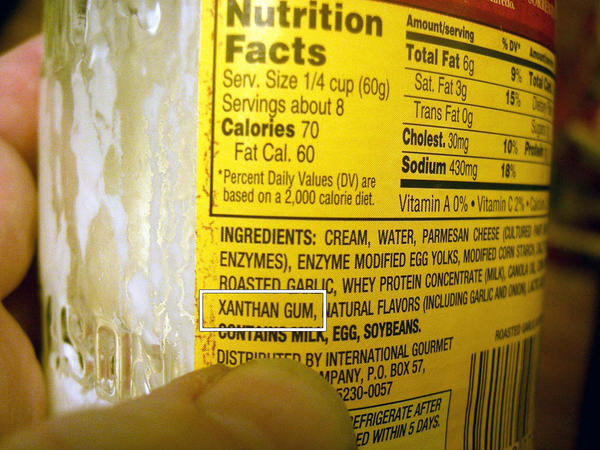 Have you heard the saying “if you don’t know what the ingredient is, or you can’t pronounce it, then don’t eat it”?
Have you heard the saying “if you don’t know what the ingredient is, or you can’t pronounce it, then don’t eat it”?
Well for myself, xanthan gum has been one of those ingredients. In fact, until I researched it to answer the question of one of my readers (comment from Suzanne), I didn’t know all of the details; especially that this is another processed food additive that is made from corn!
That’s right; xanthan gum is made from corn. To produce xanthan gum (it doesn’t grow on trees, or in any garden for that matter 😉 ) glucose is fermented. That glucose (a.k.a. dextrose, or sugar) is made from corn syrup by treating the corn syrup with enzymes in order to break down the glucose polymers into their basic building blocks (for more details, read this PDF document from corn.org). One thing that you will have noted is that we are talking about sugar. Yes, glucose, dextrose, and corn syrup are all just different names for different forms of sugar. In fact, if you want to get down to the molecular level, xanthan gum is simply many sugars (saccharides) that are linked together, known as a polysaccharide.
The fact that xanthan gum is made from corn and is composed of several sugars was the most interesting point that I learned in my research. The next point to cover though is “why is xanthan gum used in processed food?” Well, even if you didn’t know exactly what it was, I bet that you’ve seen it listed on many ingredient panels. You will find it in such items as salad dressings, dips, sauces, ketchup, cream cheese, ice cream, mayonnaise, and even in fast food milkshakes.
In fact, if you’d like a good example of how common it is in fast food, open the online list of McDonald’s ingredients for their Big Mac (you can do this with any of their products). Click the Nutrition Link on this page and scroll down the page to read the Ingredients. You’ll see Xanthan Gum listed in their Big Mac Sauce. For an easy way to scan the ingredients, use your keyboard shortcut Ctrl + F (if you are using Firefox or IE) and enter “xanthan” in the search box.
As long as you’re there, notice the high fructose corn syrup, sugar, corn syrup, and more “gunk” that seems to Never End in their ingredients.
The reason that xanthan gum is used in the “liquid type” of products is because it thickens them and gives them a certain viscosity. For example, when used in salad dressings, it gives the product a homogeneous (the same look throughout the bottle) while it’s sitting on the shelf, but when you shake it up, the liquid thins in order to allow you to pour it from the bottle. Basically it gives stability to the product, just like so many other processed food additives. (For more details, see the “Uses” section here.)
The next question is “is xanthan gum healthy for my body?” You already know that I believe that the best thing you can do for your body is to eat simple, whole foods, sans the additives, preservatives, sweeteners, refined sugars, all of those ingredients that are added to processed foods. However, based on my research I found that xanthan gum could be harmful to you if you have an allergy to corn.
If you already know that you are allergic to corn, then you are aware of every manufactured ingredient that is made from corn. However, if you don’t know that you are allergic to corn, you could be having allergic reactions from foods that contain xanthan gum and not know that it is corn that you are allergic to. This is because when xanthan gum is listed in the ingredients of a processed food, the label doesn’t state, “made from corn”. So, unless you went to an allergist (which would be the proper action suggested if you suspected you had allergies), you could be very confused as to what the source of your allergies were.
All in all, I stand by my opinion that I would love to see the corn growers earn their living from selling corn that is used to produce fuel for our vehicles. I don’t have anything positive to say about any of the additives made from corn that I’ve written about here at Fearless Fat Loss that are so prevalent in processed and fast food (HFCS, crystalline fructose, corn syrup solids, corn sugars, and now xanthan gum) mainly because they are sugar, and you know my stance on sugar.





JoLynn, I’m really enjoying your blog.
I have wondered what xanthan gum was. It’s very disturbing what is put in our food.
I just found your site, and wanted to say thanks! I began cutting all processed food out of my family’s diet about a month ago-it’s refreshing to find someone who feels the same. Now that I’m educating myself, I’m appalled at what is in our food. The family is putting up a fight, but since I can’t control what they eat when they aren’t home, they can live with my choices!
Thanks again JoLynn-you have gained another loyal reader!
Thanks JoLynn, I had seen xanthan gum on icecream before and wondered what it was. Apparently all kinds of yucky stuff goes into icecream.
Hi, thank you so much for each of your comments! 🙂
@Dee, cool, I’m very happy to hear that you’re enjoying what I’m writing, that makes it worth my time to keep spreading the word!
@Lullaby, hi, and welcome! I love hearing about other people who are making a lifestyle change and getting off of the processed food. There truly is so much gunk in the store bought food, and where does all of that go when we eat it? No one can convince me that there is not a correlation between the drastic change in our food system in the past 30 years and the increase in both disease (physical and mental) and obesity.
And, you’re welcome, thanks for subscribing!
@Catherine, sure np! You’re right, in addition to the sugar and other additives (incl. xanthan gum), ice cream is chock full of unhealthy ingredients. Now I’m not someone that recommends dairy, but I think you would be better off making homemade ice cream….does anyone do that anymore? I haven’t seen it done since I was a kid, and I never tried it myself.
I had to smile when I saw this headline. I know exactly what xanthun gum is. I used to use it to thicken up some of the skin care products that I sell. It does not take a lot to get the consistency I need to otherwise “watery oils” maybe a 1/4 tsp? I switched to guar gum simply because I like it much better. I found you through Cath Lawson by the way. I really like your website.
Hi Opal, thanks for your comments! 🙂
That is funny. I found it very interesting when I was researching this that people who are allergic to corn have to avoid cosmetics (or any products) that contain xanthan gum.
I’m glad you found me through Catherine’s blog, and thank you so much for your compliments! It helps me a lot to know that people are getting something positive out of what I’m writing here on my site. 🙂